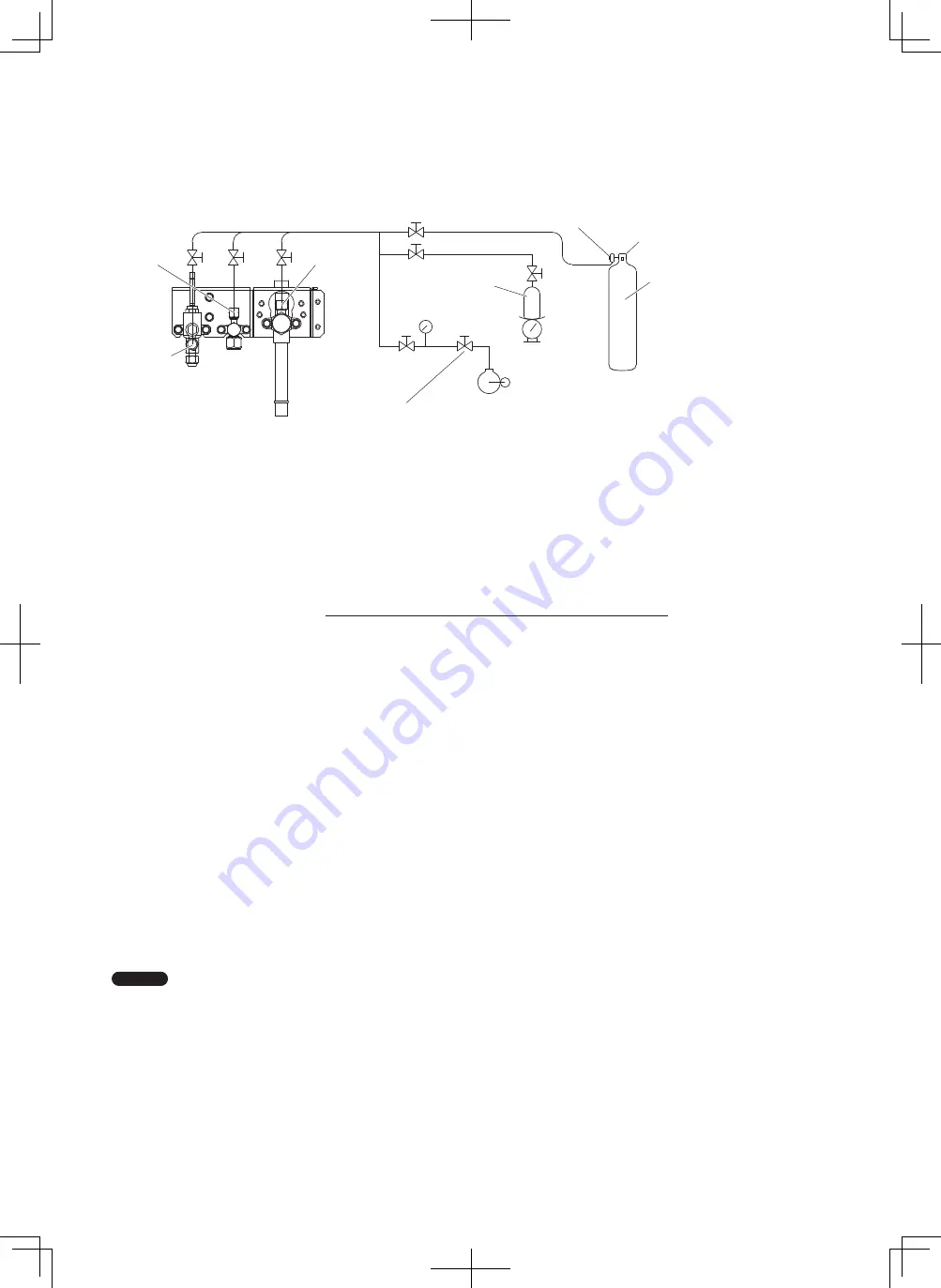
43
6. AIR PURGING
Leak Test and Evacuation
Do a leak test by performing the following procedures. Confirm that there is no leakage in the connection area.
●
Connect the nitrogen gas cylinder, refrigerant cylinder and vacuum pump to the service ports of the gas tube, liquid tube and
balance tube as shown in figure. Be sure to keep the valves of gas tube, liquid tube and balance tube closed.
Service port
Service port
Service port
Balance
tube
Mass scale
Valve A
Vacuum gauge
Refrigerant cylinder
Pressure gauge
Pressure reduction valve
Nitrogen gas cylinder
Liquid
tube
Gas tube
Vacuum pump
(Backflow prevention function provided)
Check the gauge value with the valve closed.
Confirm the vacuum gauge is below -0.1 Mpa (absolute pressure 0.6 kPa (5 Torr)).
Leak Tightness Test Method :
The design pressure and the pressure of the leak test of this unit is 3.8 MPa.
●
D
o not pressurize to the default value at once. Pressurize gradually.
(1) Pressurize to 0.5 MPa and then leave it for 5 minutes to ensure that the pressure does not drop.
(2) Pressurize to 1.5 MPa and then leave it for 5 minutes to ensure that the pressure does not drop.
(3) For the test, pressurize to 3.8 MPa and leave it for about 1 day to ensure that the pressure does not drop.
(4) The pressure drops at a rate of approximately 0.01 MPa per 1
°C decrease in ambient temperature.
Therefore, make a pressure correction. The equation for the pressure correction is given below.
Measured absolute pressure =
(Pressurized absolute pressure) × (Measured tempe273)
(Pressurized tempe273)
(5) In case that the pressure drop is observed, there is a possibility of leakage. Make a correction and perform the leak test again.
Evacuation Method :
●
After performing the leak test, evacuate and perform vacuum drying the indoor unit and tubing.
(1) Confirm that the shut-off valves of gas tube, liquid tube and balance tube are kept closed.
(2) Connect the vacuum pump and vacuum gauge to the service ports of the gas tube, liquid tube and balance tube as shown in
figure.
(3) Evacuate and perform vacuum drying the indoor unit and tubing.
(4) Evacuate until the reading of the vacuum gauge reaches less than -0.1 MPa (absolute pressure 0.6 kPa (5 Torr)) or lower.
(5) When the gauge reading is less than -0.1 MPa, run the vacuum pump for over one hour continuously and then evacuate and
perform vacuum drying.
(6) Fully close the valve A. Then loosen the hose connected to the vacuum pump and turn off the vacuum pump.
(7) After leaving it for one hour, confirm the pressure of the vacuum gauge does not increase shortly after Step (6) above. Then
stop vacuum drying.
In case that the pressure of the vacuum gauge is increased, water might be left inside of the tube or leaked. If any water remains inside
the tube, fill with the dry nitrogen (0.05 MPa (gauge pressure)) until the positive pressure is reached. Then evacuate and perform
vacuum drying again. (Due to prevention of humid air entering the pipe before returning to positive pressure.)
If there is any water leakage, eliminate leaks and perform the leak test again, and then evacuate and perform vacuum drying again.
NOTE
Be sure to perform the operations from all service ports simultaneously.
It is recommended that the leak test for the tubing among the first unit be checked without connecting to the outdoor unit: tube alone.
Use nitrogen gas for the leak tightness test. (Oxygen, carbon dioxide gas and freon gas shall be prohibited.)
•
Be sure to use vacuum gauge. Gauge manifold cannot read precisely.
•
Use the vacuum pump with the backflow prevention function. If not, there is a risk that the oil filled in the vacuum pump will flow back
when the vacuum pump is stopped.
00_340994_2WAY_Eng.indb 43
2022/8/4 14:28:46
















































